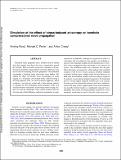Simulation of the effect of stress-induced anisotropy on borehole compressional wave propagation
Author(s)
Fang, Xinding; Cheng, Arthur; Fehler, Michael
DownloadFang-2013-Simulation of the ef.pdf (3.424Mb)
PUBLISHER_POLICY
Publisher Policy
Article is made available in accordance with the publisher's policy and may be subject to US copyright law. Please refer to the publisher's site for terms of use.
Terms of use
Metadata
Show full item recordAbstract
Formation elastic properties near a borehole may be altered from their original state due to the stress concentration around the borehole. This can lead to an incorrect estimation of formation elastic properties measured from sonic logs. Previous work has focused on estimating the elastic properties of the formation surrounding a borehole under anisotropic stress loading. We studied the effect of borehole stress concentration on sonic logging in a moderately consolidated Berea sandstone using a two-step approach. First, we used an iterative approach, which combines a rock-physics model and a finite-element method, to calculate the stress-dependent elastic properties of the rock around a borehole subjected to an anisotropic stress loading. Second, we used the anisotropic elastic model obtained from the first step and a finite-difference method to simulate the acoustic response of the borehole. Although we neglected the effects of rock failure and stress-induced crack opening, our modeling results provided important insights into the characteristics of borehole P-wave propagation when anisotropic in situ stresses are present. Our simulation results were consistent with the published laboratory measurements, which indicate that azimuthal variation of the P-wave velocity around a borehole subjected to uniaxial loading is not a simple cosine function. However, on field scale, the azimuthal variation in P-wave velocity might not be apparent at conventional logging frequencies. We found that the low-velocity region along the wellbore acts as an acoustic focusing zone that substantially enhances the P-wave amplitude, whereas the high-velocity region caused by the stress concentration near the borehole results in a significantly reduced P-wave amplitude. This results in strong azimuthal variation of P-wave amplitude, which may be used to infer the in situ stress state.
Date issued
2014-05Department
Massachusetts Institute of Technology. Department of Earth, Atmospheric, and Planetary SciencesJournal
Geophysics
Publisher
Society of Exploration Geophysicists
Citation
Fang, Xinding, Michael C. Fehler, and Arthur Cheng. “Simulation of the Effect of Stress-Induced Anisotropy on Borehole Compressional Wave Propagation.” Geophysics 79, no. 4 (May 27, 2014): D205–D216. © 2014 Society of Exploration Geophysicists
Version: Final published version
ISSN
0016-8033
1942-2156